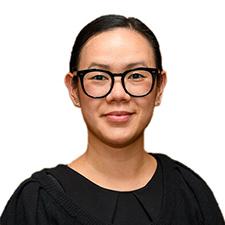
Enlisting migration agents in the fight against slavery

Carolyn Liaw, Research Officer, Anti-Slavery Australia
Profile page
Around the world, some 40.3 million people live in modern slavery according to global estimates. And the exploitation of people caught in damaging cycles of debt, coercion, and – at its worst – physical or sexual violence, is not just happening overseas.
Up to 1900 people are estimated to be living in modern slavery in Australia and only one in five victims is ever identified according to a 2017 report by the Australian Institute of Criminology. Anti-Slavery Australia (ASA) – a specialist legal, research and policy centre in the Faculty of Law at UTS – works with hundreds of survivors and people at risk right across the country every year.
“Many people are unaware that modern slavery happens in Australia,” says Carolyn Liaw, an ASA researcher and recipient of a Social Impact Grant in 2019 for her work in the area.
This is because a complex range of individual and societal factors can combine to effectively limit a person’s choices.
“It’s most often not as straightforward as physical restrictions on a person’s liberty.”
“Modern slavery in Australia probably looks a lot different to how many people imagine it to be,” says Carolyn. “People often come to Australia on the promise of a job with decent working conditions but find themselves deceived, threatened and abused by their employers. Fear, isolation and possibly shame may mean that people are trapped in these exploitative situations for years.”
For these reasons, modern slavery occurs in Australia against a backdrop of ordinary life: in quiet suburban streets, busy urban centres and rural areas alike.
“It might be the person working in your local café or restaurant, the shop assistant in a retail outlet, or a person on a construction site that you just walked by,” Carolyn says.
“Just as easily, it could be someone picking fruit and vegetables on a farm or a domestic worker living and working with a family on your street.”
Those working in the country on a temporary basis, including international students, are particularly vulnerable.
“Employers or third parties often use a migrant worker’s precarious visa status to exert influence and control,” explains Carolyn.
“The restrictions on the hours that international students can work, and often a lack of social networks and supports, can leave them vulnerable to more serious labour exploitation than the local population.”
Migration agents – who deal with visa applications on a day-to-day basis – are in a good position to recognise potential red flags in their workload and refer victims to specialist support services.
However, many – particularly those who are newly registered – may not have the specialist skills and knowledge required to do so.
In recognition of this, Carolyn worked with the then interim deputy director at ASA, Yvette Selim, to develop a tailored education package to increase the capacity of migration agents to identify potentially exploitative situations and respond appropriately.
As part of this process, they drew on the knowledge of migration agents who had experience working in a range of countries, and in commercial and not-for-profit practices.
“They assisted us in refining some of the warning signs for exploitation specific to their profession such as when the visa or prospective visa holder does not communicate with the migration agent at all and communication is filtered through a third party or visa sponsor.”
At the end of the training, the agents Carolyn and Yvette worked with were not only able to identify the indicators of modern slavery, but also reflected on how it related to their own work – with some recognising potential victims from amongst the clients they had seen in the past.
Longer term, dependent on university resourcing and the ongoing and unpredictable impacts of COVID-19, ASA hopes to trial the training program more widely.
“The better we are at tailoring and refining the topic of modern slavery to the audience, the more agents will be in a better position to identify how it intersects with their work, and identify potential victims or people at risk,” says Carolyn.
All ASA courses – including a free course for members of the public and a paid course for businesses – are available from the ASA website.
Note: Dr Yvette Selim has completed her secondment with Anti-Slavery Australia and has returned to her substantive position within UTS at the Institute for Public Policy and Governance.
The Problem
Because modern slavery is based on complex societal and personal factors, exploitation is often hidden in plain sight. Migrant workers and others on temporary visas are particularly vulnerable.
The Response
Carolyn Liaw and Yvette Selim from Anti-Slavery Australia – a specialist legal service and research and policy centre run out of UTS – consulted with migration agents to adapt training resources to meet the specialised needs of the profession.
What helped accomplish this?
The project team was able to make connections with four migration agents who had experience in multiple international jurisdictions. The agents helped Carolyn and Yvette refine their content – giving more information on potential warning signs for exploitation specifically relevant to the cohort.
What has changed as a result?
At the end of the training program, the migration agents Carolyn and Yvette worked with were better able to identify indicators of modern slavery and understand how modern slavery intersects with the migration process. In future, ASA hopes to roll out more specialised training programs to community practitioners.
Download full case study
